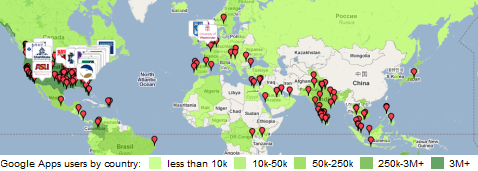What do Google and Microsoft gain from student cloud services?

Google announced yesterday that over 5 million students have now "gone Google", in that these students will start their academic sessions using the Google Apps Education Edition.
Along with this, they have a new site which shows where Google Apps has been rolled out across the globe, along with reasons to switch and case studies. Microsoft on the other hand are maintaining their efforts to compete with their rival service.
Google Apps statistics (as of today)
Google has now rolled out Apps to roughly 5 million students across 145 countries, which has increased roll-out by 400% since last year. "Thousands of schools" have picked up Google Apps with colleges following behind, and universities the least. However as a result of switching, some institutions such as the University of Notre Dame saved $1.5 million in costs.In-depth statistics are unavailable at the time as Google don't seem to want the world to know accurate figures. My guess is with the Google/Microsoft competitiveness, it's an easier way to psych out the opponent.
Microsoft Live@edu statistics (as of today)
Microsoft's statistics are much more clear cut, which is obvious as they are creeping ahead in the education market with their cloud student services. Live@edu is used by "thousands of schools" in over 86 countries and the user base has more than doubled to 10 million users since Februrary (this year, presumably).Again, more in-depth analysis of the figures are hard to come by with the corporate spiel spouting more self-promotion to a journalist who just wants the numbers to crunch. Had Microsoft provided more in terms of numbers to the public relations officer, it would have made me certainly a less-grumpy blogger for this time of morning.
The reason for providing free cloud services
In both cases of Google Apps and Microsoft's Live@edu, both use the phrase "thousands of schools". There isn't very much in it between the companies except Google is reaching out to regions Microsoft hasn't hit yet.The main differentiator is the number of students actually signing up for accounts. It seems based on the figures that schools offering Live@edu have more students actually signing up for accounts than those at schools offering Google Apps. There is no definitive answer as to why this is the case but it is an interesting trend nonetheless.
But what is in it for the companies?
It has come to my attention that Google uses the Apps Education Edition as a way of branching out to more customers as the software is free to use. Google makes their money from rolling out Apps to enterprises; the business which can afford to spend money somewhat lavishly. Google appear to be relying on these educational establishments to provide credibility and references to potential enterprise customers.
To be fair, it is good business sense as it is the least schools can do after saving millions of dollars in running and maintenance costs of their own systems.
Microsoft uses Live@edu as a testing ground for their own products. Outlook Live uses Exchange Server 2010 which only a few months ago was the only public viewing of the service. With that, Microsoft has gained around a year's worth of feedback and user data before Exchange 2010 had even been released, allowing them to make products better based on error reports and usage et al.
This is also one of the reasons why Live@edu users will be given first hand access to Office Web Applications. As my PR contact pointed out, it is an easy way to stress-test the system before bigger and badder companies start adopting the service.
It's an interesting approach, and both companies are providing their products free for a reason. Perhaps now this will shed some light on the internal processes both Microsoft and Google take into account when offering free services or products.
What do you think? Ethical? Unethical? Good business practice or doomed to bite them in the arse?
